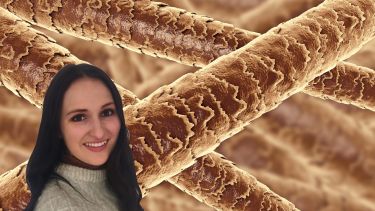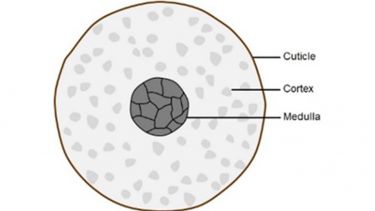- PhD Reasercher Ella Hudson, based at The University of Sheffield, uses the Royce Equipment Access Scheme to use the Hysitron TI Premier Nanoindenter to ascertain the contribution of the hair cuticle to the mechanical properties of the whole fibre.
- The objective of this work is to see whether a novel haircare treatment could restore the nanomechanical properties following a damaging treatment
- Typical techniques in the study of hair characteristics generate data representative of the entire fibre (Yu et al. 2017), but the use of the Nanoindenter will enable localised measurements of hardness properties of only the surface of samples.
A project led by Ella Hudson, PhD Researcher at The University of Sheffield, seeks to ascertain the contribution of the hair cuticle to the mechanical properties of the whole fibre.
The objective of this work was to ascertain if a novel haircare treatment could restore the nanomechanical properties of the cuticle of hair fibres following a damaging treatment and also to investigate the effect of hair type (ethnicity). To achieve this the cuticular nanomechanical properties of hair were investigated in three states, with samples of two different types of hair: African and Caucasian, which is typical for the literature in this field:
- Untreated (healthy) hair,
- Damaged hair, and
- Damaged hair treated with the novel treatment.
Under investigation was the contribution of the cuticle (surface layer) to the mechanical properties of a whole fibre. However, the techniques that are typically used to study the mechanical properties of hair generate data representative of the entire fibre (Yu et al. 2017). Nanoindentation enables the localised measurement of hardness properties of only the surface of samples
Understanding the structure of hair fibres
Hair fibres are hierarchically organised and consist of three basic structural units: i) a protective outer layer called the cuticle, ii) a central core called the cortex, and, in some instances, iii) a porous channel called the medulla (Figure 1) (Robbins 2013).
Findings
The Nanoindentation data showed no significant differences between the treatment groups for either African or Caucasian hair. These results differ from whole-fibre mechanical testing which show clear treatment differences, this clearly indicates that the internal structures of hair fibres (the cortex and the medulla) respond the most to the damaging and restorative treatments, and not the cuticle.
The comparison between African and Caucasian hair types for all three treatment groups (untreated, damaged, and restored) showed that that the cuticle layer of the African hair sample had higher reduced elastic modulus and hardness values than the Caucasian sample, which demonstrates the innate cuticle differences as a function of hair type.
Previous work by Ella on the mechanical properties of hair fibres focussed on the analysis of population variation and how that can change following different treatments was reinforced by the Nanoindentation data. In general, damaging treatments reduce the variation compared to untreated hair. The novel restorative haircare treatment does appear to restore this population variance towards the pre-damaged state, in agreement with the mechanical property data collected on whole-fibres.
Noticed in the data was the interesting phenomena that, following the application of the novel treatment to damaged hair, there was bimodal distribution not seen in the untreated or damaged hair groups. There is currently no definitive explanation to this, but may be due to the innate differences between individual hair fibres, for example, the presence of a medulla.
Next Stages
Ella intends to to continue to characterise hair in different damage states and investigate the efficacy of restorative treatments.
Equipment Access
Hysitron TI Premier Nanoindenter, Nanocharacterisation Laboratory, Royce Discovery Centre, Royce at the University of Sheffield


